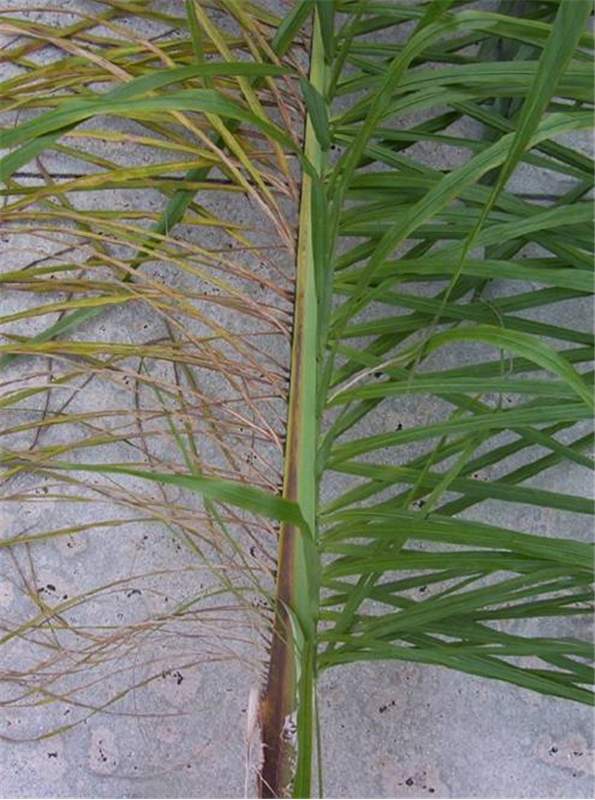Fusarium Wilt of Queen and Mexican Fan Palms
|
Figure 1. Initial symptoms on Syagrus romanzoffiana. Only a few leaflets on one side of the rachis have died. Note the reddish-brown stripe on the rachis. Photo by M. L. Elliott.
|
|
Figure 2. Leaf of Syagrus romanzoffiana with necrotic leaflets on one side and healthy leaflets on the other side of the rachis due to Fusarium wilt. Photo by M. L. Elliott
|
|
Figure 3. A cross-section of a Syagrus romanzoffiana rachis illustrating the internal discoloration due to Fusarium Wilt. Photo by T. K. Broschat.
|
|
Figure 4. These dying Washingtonia robusta leaves have a brown stripe on the petiole due to Fusarium wilt. Photo by M. L. Elliott.
|
|
Figure 5. Washingtonia robusta leaf with one-sided discoloration and death of leaf segments due to Fusarium wilt. Note the brown stripe on the petiole is on the same side as the necrotic leaf segments. Photo courtesy of University of Florida/IFAS.
|
|
Figure 6. A nearly dead Syagrus romanzoffiana due to Fusarium wilt next to healthy palms. The palm leaves turn necrotic but do not break or collapse around the trunk. Photo by M. L. Elliott.
|
Scientific name of pathogen
Fusarium oxysporum f. sp. palmarum: Kingdom Fungi, Phylum Ascomycota
Hosts
The primary hosts of Fusarium oxysporum f. sp. palmarum are Syagrus romanzoffiana (queen palm) and Washingtonia robusta (Mexican fan palm). Phoenix canariensis (Canary Island date palm) has also been confirmed as a host.
Distribution
USA (Florida, Texas)
Symptoms/signs
Initial symptoms normally occur on the lowest (oldest) living leaves in the canopycanopy:
the cluster of leaves borne at the tip of the stem
. For Syagrus romanzoffiana, there will be at least one leaf with leaflets, either all of them or only a portion, on only one side of the rachisrachis:
the axis of a leaf beyond the petiole or an extension of the petiole into the leaf blade
that will be discolored, usually a shade of brown due to desiccation or death. The leaflets on the opposite side of the rachisrachis:
the axis of a leaf beyond the petiole or an extension of the petiole into the leaf blade
will be a healthy green color (Figs. 1 and 2). This very distinctive symptom is often referred to as a “one-sided wilt” or “one-sided death”. A reddish-brown or dark-brown stripe will be observed on the petiolepetiole:
leaf stem
and rachisrachis:
the axis of a leaf beyond the petiole or an extension of the petiole into the leaf blade
of the affected frond, on the same side where the first dead leaflets appear. This streak may run the full length of the petiolepetiole:
leaf stem
and rachisrachis:
the axis of a leaf beyond the petiole or an extension of the petiole into the leaf blade
, or just a portion of it. Internal discoloration will be observed in cross-sections of the discolored petiolepetiole:
leaf stem
and rachisrachis:
the axis of a leaf beyond the petiole or an extension of the petiole into the leaf blade
(Fig. 3). Eventually the leaflets on the other side of the rachisrachis:
the axis of a leaf beyond the petiole or an extension of the petiole into the leaf blade
will turn brown also, and the entire leaf dies.
For Washingtonia robusta, there will be at least one older leaf with a mixture of healthy, chloroticchlorotic:
see chlorosis
and necroticnecrotic:
see necrosis
leafletleaflet:
divisions of pinnate leaves
segments in the leaf bladeleaf blade:
the broad, flattened distal portion of a leaf
(Figs. 4 and 5). As with the above palm species, there will be a reddish-brown or dark-brown stripe on the petiolepetiole:
leaf stem
, with a corresponding internal discoloration observed in cross-section.
For both palm hosts, the disease symptoms normally begin on the lowest (oldest) leaves and then move up the canopycanopy:
the cluster of leaves borne at the tip of the stem
, progressively killing younger and younger leaves. In all situations, the spear leafspear leaf:
the younges emerging leaf that has not yet opened
is the last leaf to die.
Fusarium wilt of Syagrus romanzoffiana and Washingtonia robusta develops very quickly. These palms often die within 2 to 3 months after initial symptom development. Due to the quick decline, a very characteristic symptom of this disease is the overall canopycanopy:
the cluster of leaves borne at the tip of the stem
appearance. The necroticnecrotic:
see necrosis
leaves do not droop or break and bend down around the trunk, but remain relatively rigid (Fig. 6).
May be confused with
Petiole petiole:
leaf stem
(rachis) blight causes the same leaf symptoms in palms. Laboratory diagnosis is necessary to confirm which pathogen is responsible for the symptoms. It is possible for a Fusarium wilt pathogen and a petiole (rachis) blight pathogen to be present in the same tissue.
Additional comments
Three other Fusarium oxysporum formae speciales occur on palms. Fusarium oxysporum f. sp. canariensis causes Fusarium wilt of Phoenix canariensis and occurs in Argentina, Australia, the Canary Islands, France, Greece, Italy, Japan, USA (California, Florida, Nevada, Texas). Fusarium oxysporum f. sp. albedinis causes Fusarium wilt of Phoenix dactylifera, but is limited to Morocco, Algeria and Mauritiana. Fusarium oxysporum f. sp. elaeidis causes Fusarium wilt of Elaeis guineensis, but is limited to western African and very limited areas within Ecuador and Brazil.




